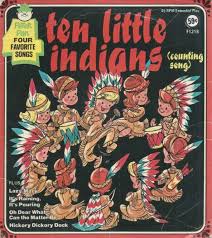Ten Little Indians
Ten Little Indians is a children's counting rhyme. The term "Indians" is actually referring to American Indians. Around the year of 1868, American songwriter Septimus Winner adapted the verse for a song, naming it “Ten Little Injuns.”[1] It was in 1869, the song was adapted by Frank J. Green as Ten Little Niggers and became a standard of the blackface minstrel shows in England and America. As time goes, the usage of N-word became controversial. Therefore it was changed back to Indians, then to soldiers, then teddy bears, then bunnies, and lately as bunnies dressed as Indians. [2]
Modern Lyrics
Taken from allnurseryrhymes.com, the modern lyrics for the children's rhyme are:
"One little, two little, three little Indians"
"Four little, five little, six little Indians"
"Seven little, eight little, nine little Indians"
"Ten little Indian boys."
"Ten little, nine little, eight little Indians"
"Seven little, six little, five little Indians"
"Four little, three little, two little Indians"
"One little Indian boy."[3]
Original version
Taken from allnurseryrhymes.com, the original lyrics for the rhymes are:
"Ten little Indians standin' in a line,"
"One toddled home and then there were nine;"
"Nine little Indians swingin' on a gate,"
"One tumbled off and then there were eight."
"Eight little Indians gayest under heav'n."
"One went to sleep and then there were seven;"
"Seven little Indians cuttin' up their tricks,"
"One broke his neck and then there were six."
"Six little Indians all alive,"
"One kicked the bucket and then there were five;"
"Five little Indians on a cellar door,"
"One tumbled in and then there were four."
"Four little Indians up on a spree,"
"One got fuddled and then there were three;"
"Three little Indians out on a canoe,"
"One tumbled overboard and then there were two"
"Two little Indians foolin' with a gun,"
"One shot t'other and then there was one;"
"One little Indian livin' all alone,"
"He got married and then there were none."
Controversy
Though the historical record is inconsistent and unnoted, it is believed that British songwriter Frank Green adapted Winner’s song in 1869 with new lyrics of his own. Now entitled “Ten Little Niggers,” the lyrics to the new verse was as follows:[1]:
"Ten little nigger boys went out to dine"
"One choked his little self, and then there were nine."
"Nine little nigger boys sat up very late"
"One overslept himself, and then there were eight."
"Eight little nigger boys traveling in Devon"
"One said he’d stay there, and then there were seven."
"Seven little nigger boys chopping up sticks"
"One chopped himself in half, and then there were six."
"Six little nigger boys playing with a hive"
"A bumble-bee stung one, and then there were five."
"Five little nigger boys going in for law"
"One got in chancery, and then there were four."
"Four little nigger boys going out to sea"
"A red herring swallowed one, and then there were three."
"Three little nigger boys walking in the zoo"
"A big bear hugged one, and then there were two."
"Two little nigger boys sitting in the sun"
"One got frizzled up, and then there was one."
"One little nigger boy living all alone"
"He went and hanged himself and then there were none."(Ten Little Niggers by M' Loughlin Bro's)[4]
Due to the racist words used in the song, in the modern versions, the term is changed to "soldier boys" or "teddy bears".[5] In 2007, Ten Little Negroes was republished by the Icelanding publisher, Skrudda. They republished the original version with that contains the N-word. This caused a considerable debate of people who saw the book as racist and those who saw it as "a part of funny and silly stories created in the past".[6]
Moreover, the song also stands for murder, death, and genocide of black boys. Inspired by this song, Agatha Christie published a book in 1939 entitled Ten Little Niggers in England, followed by American reprints and adaptations where the book was retitled into And Then There Were None, using the last words of the nursery rhyme.[2]
References
- ↑ Jump up to: 1.0 1.1 Revisiting the Racism That Inspired One of the World’s Bestselling Crime Novels. medium.com. Oct 22, 2020. Retrieved Jan 13, 2021
- ↑ Jump up to: 2.0 2.1 Ten Little Indians: A Genocidal Nursery Rhyme. indiancountrytoday.com. Sep 12, 2017. Retrieved Jan 13, 2021
- ↑ https://allnurseryrhymes.com/ten-little-indians/
- ↑ Bro's, M. Loughlin. Ten Little Niggers. New York Publishers.
- ↑ R. Riley, P. McAllister, J. Symonsm B. Cassiday., The Bedside, Bathtub & Armchair Companion to Agatha Christie (Continuum, 2001), pp. 144–45.
- ↑ ristín Loftsdóttir. 2011. "Racist Caricatures in Iceland in the 19th and the 20th Century". In Iceland and Images of the North, edited by S.R. Ísleifsson. Québec: Prologue Inc, 187–204 (pp. 198—200, quoting p. 199).

